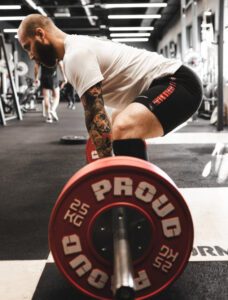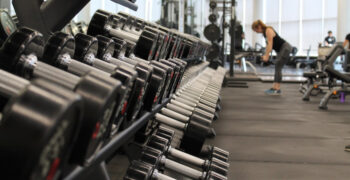There is a lot of misconception about bodybuilding. Far too many people are copying the training plans of elite bodybuilders, which is not good for an average bodybuilder.
I want to set the record straight about the reality of bodybuilding. Not just to explain the functions of bodybuilding, but also the best and most efficient training and diet plans to increase lean muscle mass.
Understanding Bodybuilding
Bodybuilding entails the use of resistance training to develop and enhance an individual’s muscles, with the primary goal being to maximize muscle growth, a process known as muscular hypertrophy. This growth primarily results from strength training, such as weightlifting.
A lot of people think of bodybuilders and immediately picture men and women under bright lights, on a stage, flexing their gigantic muscles for an audience.
Yes, these are body builders, and bodybuilding is a sport. However, there is more to bodybuilding that meets the eye and it is simply about anybody who is trying to build or sculpt their body.
Bodybuilding is a number of different exercises designed to enhance the human body’s muscular development and promote general health and fitness. It contributes not only to physical well-being but also mental fitness.
Bodybuilding decreases the risk of developing coronary heart disease. By engaging in physical activities such as weight training and aerobic exercise you have more chance to reduce and control high blood pressure, obesity and high cholesterol.
What Makes Muscles Grow?
Muscle size increases when a person continually challenges the muscles to deal with higher levels of resistance or weight. This process is known as muscle hypertrophy.
Muscle hypertrophy occurs when the fibres of the muscles sustain damage or injury. The body repairs damaged fibres by fusing them, which increases the mass and size of the muscles.
There are two types of muscular hypertrophy: myofibrillar and sarcoplasmic. Myofibrillar is an increase in myofibrils, and sarcoplasmic is an increase in muscle glycogen storage.
Bundles of muscle fibres, known as myocytes, make up the skeletal muscles. Each myocyte contains myofibrils that allow the muscles to contract. Myofibrillar hypertrophy refers to when the number of myofibrils increases which allows the muscles to increase in strength and density.
The muscles also contain sarcoplasmic fluid. This fluid surrounds the myofibrils in the muscles and works as an energy resource. During a workout, more fluid moves to the muscles to provide energy.
Certain hormones, including testosterone, human growth hormone, and insulin growth factor, also play a role in muscle growth and repair.
There are three primary mechanisms of muscle growth: Muscle tension, metabolic stress and muscle damage. Often times all of these factors are correlated with the amount of weight you lift.
Compound Exercise vs Isolation Exercises
Weight training can be put into 2 types of exercise, either compound exercise or isolation exercises. Your overall goal will depend on whether to incorporate more compound exercises or isolation exercises into your training plan.
Compound Exercises
Compound exercises require using multiple muscle groups or joints at a time. They are efficient and save us time by utilizing multiple muscles at once.
The multiple movements that take place during a compound exercise prepare your body to lift heavier loads than isolation exercises, due to the number of different movements that take place.
Compound exercises utilize more muscles to complete the workout, creating a hormonal response of testosterone which can repair damage to your muscles and help you maintain your gains.
If you’re looking to improve at sports or other athletic activities, compound exercises can help you reach your goals. They can help to increase your fitness by working multiple joints and muscles at the same time, helping you burn more calories because you’ll expend more energy.
My top 3 compound exercises for each muscle group are:
Legs
- Squats (Barbell)
- Romanian Deadlift
- Deadlift (Barbell)

Calves
- Standing Calf Raises
- Seated Calf Raise
- Farmers Carry
Chest
- Bench Press (Barbell)
- Incline Bench press (Dumbbell)
- Chest Dip
Back
- Bent-Over Row
- Lat Pulldown
- Pull-Up

Shoulders
- Seated Barbell Press
- Arnold Press
- T-bar Rows
Biceps
- Barbell Drag Curls
- Chin-Up
- Dumbbell Hammer Curls
Triceps
- Parallel Bar Dips
- Close-grip Bench Press
- Behind Neck Press
Isolation Exercises
Isolation exercises are designed to ‘isolate’ a particular muscle, and can be used for improving muscular imbalances. Whilst no exercise will only use one muscle group, isolation exercises specifically target one area. Isolation exercises are best used in advanced training routines, once you have built good over-all strength.
My top 3 isolation exercises for each muscle group are:
Legs
- Leg Press
- Lying Leg Curls
- Leg Extensions
Chest

- Incline Dumbbell Flyes
- Incline Cable Flyes
- Decline Cable Flyes
Back
- Seated Lower Back Extension
- Trap Bar Shrug
- Bent-Arm Barbell Pullover
Shoulders
- Dumbbell Lateral Raise
- Dumbbell Front Raise
- Reverse Fly
Biceps
- Dumbbell Bicep Curl
- Barbell Bicep Curl
- Rope Cable Curl
Triceps
- Cable Tricep Extension
- Dumbbell Tricep Kick-Back
- Overhead Cable Tricep Press
Bodybuilding Body types
There are three types of bodies: ectomorph, endomorph and mesomorph. These body types are used to describe the muscle mass, bone density and fat storage in a person’s body. Your body type can have a huge impact on how fast you gain muscle and lose weight.
Once you know your body type you can use this to your advantage and plan the most suitable training and diet plan that will help you to achieve your goals. When you’ve factored in your body composition it will help you to reach your goals that much quicker.
Endomorph Body type
Endomorphs have broader bone structures and softer looking bodies. They carry a lot more body fat and have a larger midsection and hips. They gain fat faster and lose it slower than the other Body types.
Endomorphs have a slower metabolism; potentially due to chronic conditions (e.g., thyroid deficiency, diabetes) but is often due to sedentary habits and long-term positive calorie balance.
Exercise is vital for good health. This is especially true as an endomorph, as you tend to store fat easily and have difficulty losing weight. You may need a specialized diet plan and fitness method to reach your health goals and an appropriate weight.
Ectomorph body type
Ectomorphs have more narrow shoulders and hips in respect to their height. They have a relatively smaller bone structure in respect to bone length, which means that they are on the weaker side making them more susceptible to conditions such as osteoporosis.
They have faster metabolism to other body types making it difficult for them to gain muscle mass, but on the plus side, when you do gain muscle, this is usually lean and solid muscle
As mentioned, Ectomorphs struggle to build large muscles, but if this is your goal., you want to avoid too much cardio and aerobic exercise and focus more on compound exercises.
Mesomorph Body type
Mesomorphs have a medium bone structure with shoulders wider than the hips. Having an athletic build, a mesomorph can gain muscle relatively easily and retain it. For this reason it is often seen as the most favourable body type.
They have the most efficient metabolism, which means that although they can gain body fat quite quickly, it’s also easy for them to lose it. People with a mesomorph body type tend to make the best bodybuilders.
Building a Bodybuilding Training and Diet Plan
How you eat and exercise are crucial parts of bodybuilding. Now that you know your body type, it can help you work with your body, rather than against it, and you can set up a training and diet plan that will work best for you.
Ectomorphs should focus on high intensity and high volume training. Lifting heavy weights for a lot of reps is important to stimulate muscle growth and protein synthesis. Aim for 3-5 sets per exercise, with a total of 4 exercises. Increase the weight and decrease the reps after every set.
Train every muscle group twice per week and include both compound exercises and isolation exercises. Light cardio is essential for health reasons, but do not do too much it and burn excess calories that could be used for gaining muscle.
Ectomorphs should eat high calorie foods that pack a lot of energy (or calories) per gram. Choose animal protein sources, focus on whole grains that are packed with vitamins and minerals in addition to carbs. Fats are also an easy way to boost your calorie intake
Endomorphs should focus on burning fat through a combination of cardio and weight training. Interval training utilizing exercises that work your whole body (sprints, box jumps, etc), will help you strip away body fat.
Unfortunately, Endomorphs have to watch what they eat more than other body types. You should be cautious of refined carbohydrates and instead get your fix from high-fiber sources like oats, brown rice, vegetables and keep your protein intake high throughout the day, as it will help keep you on track for building muscle.
Mesomorphs should lift moderate or heavy weights since they are naturally muscular to begin with. Using light weights wouldn’t be enough to work their muscles to hypertrophy, which will be necessary to see any good progress.
Mesomorphs should eat a balanced meal every few hours, which is made up of around 40% carbs, 30% protein and 30% fat. Whole grains, healthy fats, and protein-rich foods will provide the energy for workouts as well as nutrients for muscle repair.
They can also usually eat more calories compared with the other body types, as their higher percentage of muscle means a much faster metabolism.
Now that you know your body type you can use the above information to build your own training and diet suitable for your body type. You can incorporate compound and isolation exercises into your training plan depending on which exercises work best for you.
I hope this post is helpful and gives you a better understanding of bodybuilding. If you have any questions, comment below and I will reply as soon as possible.
